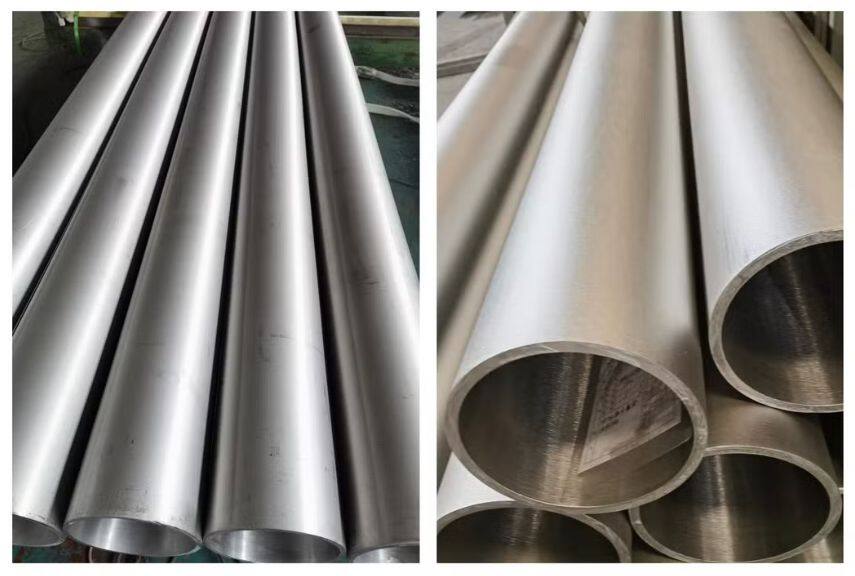-
 Laijing Bu
Hi there! Welcome to my shop. Let me know if you have any questions.
Laijing Bu
Hi there! Welcome to my shop. Let me know if you have any questions.
Your message has exceeded the limit.

How to choose suitable industrial stainless steel pipes
2025-07-15 13:17:15
Choosing suitable industrial stainless steel pipes requires comprehensive consideration of various factors such as usage environment, performance requirements, and cost budget. The following are specific selection points and suggestions:
1、 Clearly define the usage scenarios and operational requirements
1. Type of medium
Corrosive media, such as chemical solutions, seawater, acidic/alkaline liquids, etc., require special attention to the corrosion resistance of stainless steel (such as 316L, 2205 duplex steel, etc.).
High temperature medium: such as steam, high-temperature oil, etc., high-temperature resistant stainless steel (such as 310S, 321, etc.) should be selected.
High pressure medium: such as high-pressure pipeline systems, the strength and wall thickness of the pipes need to be considered (such as seamless steel pipes and thick walled pipes).
2. Temperature and pressure range
Temperature: For low-temperature environments (such as -196 ℃ liquid nitrogen), materials with good low-temperature toughness (such as 304L, 316L) should be selected; High temperature environments (such as above 600 ℃) require the selection of heat-resistant steel (such as 310S, Incoloy 800).
Pressure: Select the pipe wall thickness grade (such as Sch40, Sch80) based on the design pressure of the pipeline system, and prioritize seamless steel pipes for high-pressure scenarios.
3. Installation environment
Indoor/Outdoor: The impact of ultraviolet radiation and humidity on stainless steel needs to be considered in outdoor environments (for example, 304 may rust in humid environments, and 316 or higher grade should be selected).
Vibration or impact scenarios: For equipment connecting pipes with high mechanical vibration, it is necessary to choose pipes with high strength and good vibration resistance (such as thick walled seamless pipes).
2、 Choose the appropriate stainless steel material
1. Common types and characteristics of industrial stainless steel
Picture 1
2. Material selection logic
Corrosion priority: If the medium has strong corrosiveness, duplex steel (such as 2205) or high nickel stainless steel (such as 904L) is preferred.
Strength priority: Choose duplex steel or thick walled austenitic stainless steel for high-pressure or load-bearing scenarios.
Cost control: Choose 304 for non corrosive scenarios and 316L for moderate corrosion scenarios to avoid excessive selection and increase costs.
3、 Determine pipe specifications and manufacturing standards
1. Specification parameters
Outer diameter and wall thickness: Calculate the pipe diameter based on the flow rate (refer to the fluid mechanics formula), and the wall thickness should comply with the pressure rating (such as ASME B36.10 seamless steel pipe standard).
Length and tolerance: Industrial pipes are usually of fixed length (such as 6 meters, 12 meters), and the tolerance range needs to be confirmed (such as outer diameter ± 1%, wall thickness ± 0.1mm).
2. Manufacturing process
Seamless steel pipe: made by piercing and hot rolling, with high strength and uniform performance, suitable for high-pressure, high-temperature, and high demand scenarios (such as petrochemicals and electricity).
Welded steel pipe: made by welding steel strips, with low cost and high production efficiency, suitable for low-pressure, non corrosive or general corrosive scenarios (such as buildings and water pipelines).
3. Implement standards
Domestic standards: GB/T 14976 (Seamless Stainless Steel Tubes for Fluid Transport), GB/T 12771 (Welded Stainless Steel Tubes for Fluid Transport).
International standards: ASTM A312 (American standard austenitic stainless steel seamless/welded steel pipe), EN 10216-5 (European standard pressure bearing stainless steel pipe).
4、 Pay attention to the performance and quality verification of pipes
1. Key performance testing
Corrosion resistance testing: such as intergranular corrosion test (GB/T 4334) and salt spray test (ISO 9227), to ensure that the material does not rust in the target environment.
Mechanical performance testing: tensile test (to measure yield strength and tensile strength), impact test (to measure low-temperature toughness), to meet the strength requirements of working conditions.
Pressure test: Hydraulic test (such as GB/T 241) or pneumatic test to ensure that the pipeline is leak free.
2. Quality certification documents
Require suppliers to provide material certificates (including chemical composition and mechanical properties), non-destructive testing reports (such as ultrasonic testing UT, eddy current testing ET), and heat treatment reports (if solution treatment is required).
5、 Consider cost and supply chain factors
1. Cost composition
Material cost: duplex steel>316L>304, seamless pipe>welded pipe.
Processing cost: Thick walled pipes and special specification pipes are difficult to process and have higher costs.
Maintenance cost: The initial cost of high corrosion-resistant materials is high, but the long-term maintenance cost is low (such as reducing replacement frequency).
2. Supplier selection
Prioritize selecting large steel mills or first tier agents to ensure that the source of pipes is legitimate (such as Baosteel, Taiyuan Iron and Steel, and Qingshan Holdings).
Require third-party testing reports to avoid using pipes produced from "non-standard" or inferior recycled materials.
6、 Other precautions
1. Processing and connection methods
Welding: Austenitic stainless steel requires matching welding wires (such as ER308L for 304 and ER316L for 316), while duplex steel requires controlled welding heat input to prevent embrittlement.
Flange connection: Welding flanges are used for high-pressure scenarios, while flat welding flanges are used for low-pressure scenarios. It is important to ensure that the flange material matches the pipe material.
2. Surface treatment
Acid pickling passivation: removes welding oxide skin and improves corrosion resistance (suitable for the food and pharmaceutical industries).
Polishing treatment: Inner wall polishing can reduce fluid resistance and is suitable for high-purity media such as pharmaceutical and electronic grade pure water.
Summary: Selection Process Diagram
Picture 2
Through the above steps, stainless steel pipes that meet industrial needs can be systematically selected. If the working conditions are complex (such as mixed corrosion+high pressure+high temperature), it is recommended to consult professional pipe suppliers or design institutes for joint selection.
Tags: Clearly define the usage scenarios and operational requirements, Choose the appropriate stainless steel material, Determine pipe specifications and manufacturing standards


